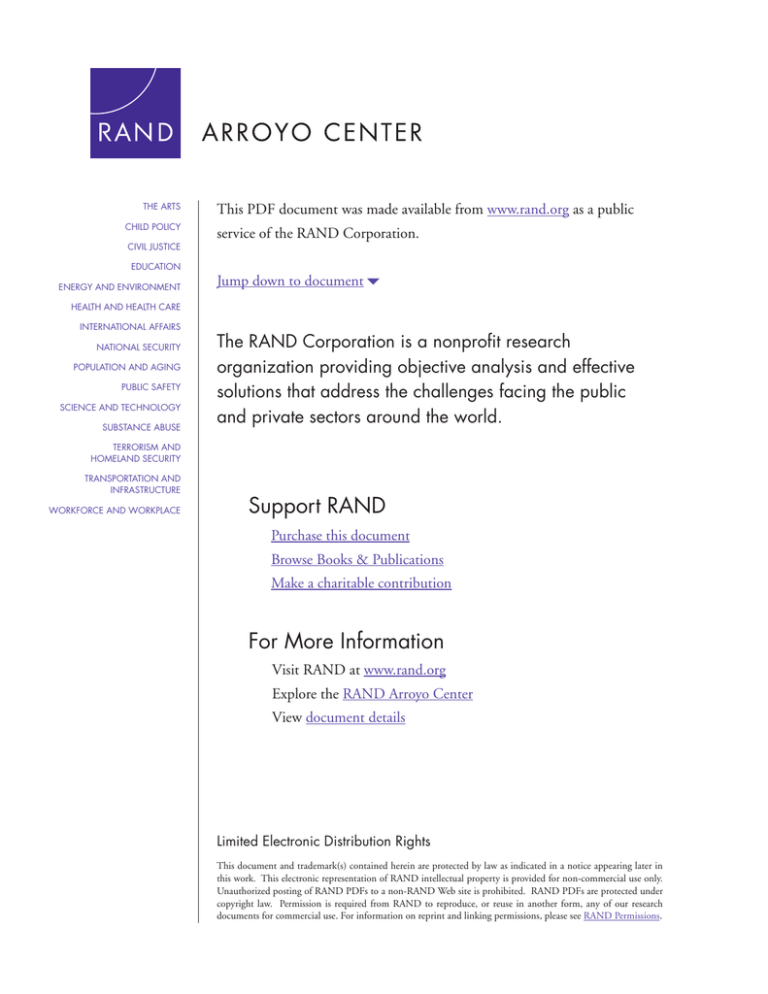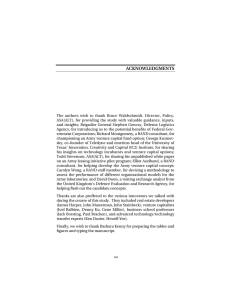6 om as a public service of the RAND Corporation.
advertisement

THE ARTS CHILD POLICY CIVIL JUSTICE EDUCATION ENERGY AND ENVIRONMENT This PDF document was made available from www.rand.org as a public service of the RAND Corporation. Jump down to document6 HEALTH AND HEALTH CARE INTERNATIONAL AFFAIRS NATIONAL SECURITY POPULATION AND AGING PUBLIC SAFETY SCIENCE AND TECHNOLOGY SUBSTANCE ABUSE The RAND Corporation is a nonprofit research organization providing objective analysis and effective solutions that address the challenges facing the public and private sectors around the world. TERRORISM AND HOMELAND SECURITY TRANSPORTATION AND INFRASTRUCTURE WORKFORCE AND WORKPLACE Support RAND Purchase this document Browse Books & Publications Make a charitable contribution For More Information Visit RAND at www.rand.org Explore the RAND Arroyo Center View document details Limited Electronic Distribution Rights This document and trademark(s) contained herein are protected by law as indicated in a notice appearing later in this work. This electronic representation of RAND intellectual property is provided for non-commercial use only. Unauthorized posting of RAND PDFs to a non-RAND Web site is prohibited. RAND PDFs are protected under copyright law. Permission is required from RAND to reproduce, or reuse in another form, any of our research documents for commercial use. For information on reprint and linking permissions, please see RAND Permissions. This product is part of the RAND Corporation technical report series. Reports may include research findings on a specific topic that is limited in scope; present discussions of the methodology employed in research; provide literature reviews, survey instruments, modeling exercises, guidelines for practitioners and research professionals, and supporting documentation; or deliver preliminary findings. All RAND reports undergo rigorous peer review to ensure that they meet high standards for research quality and objectivity. Guidebook for Supporting Economic Development in Stability Operations Keith Crane, Olga Oliker, Nora Bensahel, Derek Eaton, S. Jamie Gayton, Brooke Stearns Lawson, Jeffrey Martini, John L. Nasir, Sandra Reyna, Michelle Parker, Jerry M. Sollinger, Kayla M. Williams Prepared for the United States Army Approved for public release; distribution unlimited ARROYO CENTER The research described in this report was sponsored by the United States Army under Contract No. W74V8H-06-C-0001. Library of Congress Cataloging-in-Publication Data is available for this publication. ISBN 978-0-8330-4634-5 The RAND Corporation is a nonprofit research organization providing objective analysis and effective solutions that address the challenges facing the public and private sectors around the world. RAND’s publications do not necessarily reflect the opinions of its research clients and sponsors. R® is a registered trademark. © Copyright 2009 RAND Corporation All rights reserved. Permission is given to duplicate this document for U.S. military purposes. Copies may not be duplicated for commercial purposes. Sites are encouraged to link to the document on the RAND Web site. Unauthorized posting of RAND documents directly on a non-RAND Web site is prohibited. RAND documents are protected under copyright law. For information on reprint and linking permissions, please visit the RAND Permissions page (http://www.rand.org/publications/permissions.html). Published 2009 by the RAND Corporation 1776 Main Street, P.O. Box 2138, Santa Monica, CA 90407-2138 1200 South Hayes Street, Arlington, VA 22202-5050 4570 Fifth Avenue, Suite 600, Pittsburgh, PA 15213-2665 RAND URL: http://www.rand.org To order RAND documents or to obtain additional information, contact Distribution Services: Telephone: (310) 451-7002; Fax: (310) 451-6915; Email: order@rand.org Executive Summary Objective This guidebook is designed to help tactical and operational level commanders plan for economic issues in their areas of responsibility (AOR). It should help the reader better understand the economic forces at work in countries and regions emerging from conflict, and the activities and tasks that U.S. Army and other military personnel may take on as they provide support to economic and infrastructure development in conflict and post-conflict settings. The document draws heavily on lessons learned in current conflicts in Iraq and Afghanistan. It seeks to be of immediate assistance to those operating in these theaters. It is also designed, however, to help inform future operations. ES.1. Background ES.2. As part of stability operations, U.S. Army personnel have become increasingly involved in providing assistance to support economic and infrastructure development. Officers in Afghanistan and Iraq have had to select and implement assistance programs in their areas of responsibility. In many instances, they have requested guidance in selecting and implementing effective projects in their AOR. They have also sought to better understand the economic context of their efforts. While the U.S. Agency for International Development (USAID), among others, has produced excellent guidance for the national level, there exists little detailed guidance on tasks appropriate for Army and other military forces. This guidebook is designed to fill this gap. It presents the results of research on best practices in this area. Additionally, the Army stability task described as “support to economic and infrastructure development” is not in any organization’s Core Mission Essential Task List (CMETL). This guidebook provides a basis for the development of a Directed Mission Essential Task List (DMETL) and mission planning for commanders who receive missions with lines of effort including economic development. ES.3. To successfully support the economic development components of stability operations, tactical and operational level commanders should have a basic understanding of the most important principles of economic development, techniques that have proved successful in conflict and post-conflict environments, and the strategic economic impacts resulting from tactical interventions. The Army will often be on the ground before civilian agencies that are better suited for these types of efforts and will, therefore, have to set the conditions for these organizations. However, commanders need to be aware of other stakeholders involved in such efforts ES.4. xi xii Guidebook for Supporting Economic Development in Stability Operations and the tasks and missions that they may carry out so that the Army can better leverage available resources to accomplish its missions. Context ES.5. This guidebook focuses on the conflict and post-conflict environment. However, similar tasks in a relatively benign security environment, as part of a combatant commander’s Theater Security Cooperation Plan (TSCP), have many of the same goals. It is designed for the use of tactical and operational level leaders and their subordinate leaders, military leaders or members of Provincial Reconstruction Teams (PRTs), and others charged with providing support to economic and infrastructure development. Although civilian assistance providers are not the principal audience, they should find the guidebook a useful source of information on military roles and their relationship to broader development and stability operations efforts. Content ES.6. Chapter One, “Introduction,” gives a brief introduction to stability operations and the stability task of “support to economic and infrastructure development.” It provides a brief summary of the doctrinal underpinnings found in Army Field Manual (FM) 3-0, Operations. It also provides the purpose of the guidebook and lists a number of principles that should guide military efforts in support of economic development. Chapter One, and each successive chapter, is supplemented by a glossary of relevant economic terms found in this front matter. Chapter Two, “What You Need to Know Before You Go,” discusses the economic considerations that should be developed prior to deployment as part of the intelligence preparation of the battlefield (IPB) process and how to use the political, military, economic, social, infrastructure, information, physical environment and time (PMESII-PT) variables to gather information on how local people in the AOR make a living and survive, how the economy could recover, and how the Army can tell if its efforts are working by measuring outcomes, not inputs or outputs. This chapter offers indicators of a more stable and secure environment and of improvements in the local economy that should be visible to ground forces. ES.7. Chapter Three, “Players, Coordination, and Resources,” describes the actors engaged in economic and infrastructure development that U.S. military personnel may encounter or with whom they may work, including the host-nation government, U.S. civilian agencies, the United Nations, international financial institutions, bilateral agencies, nongovernmental organizations (NGOs), and the local society. It also discusses the resources that may be available to both U.S. military and other assistance providers to carry out projects and tasks. ES.8. ES.9. Chapters Four through Nine draw on reports from personnel who have served in Bosnia, Iraq, Afghanistan, and Liberia as well as the experiences of the foreign assistance community to provide detailed suggestions on economic programs and initiatives that have worked well. These programs and initiatives are evaluated in the following subjects, one per chapter: • Humanitarian assistance Executive Summary xiii • Infrastructure • Agriculture • Currencies, budgets, banking and finance, and foreign trade • Private sector development and employment generation • Natural resource management Each of these chapters introduces the major issues and challenges for reconstruction and development in its subject area. Each then discusses what roles host-nation governments and various international civilian donors and organizations may play in addressing these challenges. The focus is primarily at the operational and strategic level, but with an eye to drawing out the implications for military personnel and other tactical operators. Tactical operators need to understand the strategic considerations regarding host-nation roles because Army stability tasks should set the conditions for long-term development. By understanding the responsibilities of the host nation and other organizations supporting it, host-nation military personnel will understand how to implement interventions that help achieve strategic goals. ES.10. ES.11. Finally, each of these chapters addresses possible Army roles and missions, whether direct or in support of other actors, and how these relate to the economic development effort. The discussions describe in detail what military units in certain situations might be expected to provide in terms of support, and how U.S. Army personnel can work with the local population and other donors to help expand economic activity in these environments. Each chapter closes with a checklist summarizing the key economic development–related tasks that Army commands may be expected to support. ES.12. Chapter Ten focuses on how local procurement and other economic interactions between the unit and the local community can affect the local economy and how problems potentially caused by such interactions might be mitigated.




